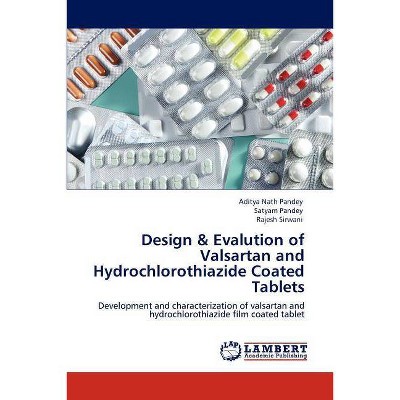Fundamentals of Electroceramics - by R K Pandey (Hardcover)

Similar Products
Products of same category from the store
AllProduct info
<p/><br></br><p><b> Book Synopsis </b></p></br></br><p><b>The first textbook to provide in-depth treatment of electroceramics with emphasis on applications in microelectronics, magneto-electronics, spintronics, energy storage and harvesting, sensors and detectors, magnetics, and in electro-optics and acousto-optics</b></p> <p>Electroceramics is a class of ceramic materials used primarily for their electrical properties. This book covers the important topics relevant to this growing field and places great emphasis on devices and applications. It provides sufficient background in theory and mathematics so that readers can gain insight into phenomena that are unique to electroceramics. Each chapter has its own brief introduction with an explanation of how the said content impacts technology. Multiple examples are provided to reinforce the content as well as numerous end-of-chapter problems for students to solve and learn. The book also includes suggestions for advanced study and key words relevant to each chapter.</p> <p><i>Fundamentals of Electroceramics: Materials, Devices and Applications</i> offers eleven chapters covering: 1.Nature and types of solid materials; 2. Processing of Materials; 3. Methods for Materials Characterization; 4. Binding Forces in Solids and Essential Elements of Crystallography; 5. Dominant Forces and Effects in Electroceramics; 6. Coupled Nonlinear Effects in Electroceramics; 7. Elements of Semiconductor; 8. Electroceramic Semiconductor Devices; 9. Electroceramics and Green Energy; 10.Electroceramic Magnetics; and 11. Electro-optics and Acousto-optics.</p> <p>Provides an in-depth treatment of electroceramics with the emphasis on fundamental theoretical concepts, devices, and applications with focus on non-linear dielectrics </p> <ul> <li>Emphasizes applications in microelectronics, magneto-electronics, spintronics, energy storage and harvesting, sensors and detectors, magnetics and in electro-optics and acousto-optics</li> <li>Introductory textbook for students to learn and make an impact on technology</li> <li>Motivates students to get interested in research on various aspects of electroceramics at undergraduate and graduate levels leading to a challenging career path.</li> <li>Includes examples and problem questions within every chapter that prepare students well for independent thinking and learning.</li> </ul> <p><i>Fundamentals of Electroceramics: Materials, Devices and Applications</i> is an invaluable academic textbook that will benefit all students, professors, researchers, scientists, engineers, and teachers of ceramic engineering, electrical engineering, applied physics, materials science, and engineering.</p><p/><br></br><p><b> From the Back Cover </b></p></br></br><p>THE FIRST TEXTBOOK TO PROVIDE IN-DEPTH TREATMENT OF ELECTROCERAMICS WITH EMPHASIS ON APPLICATIONS IN MICROELECTRONICS, MAGNETO-ELECTRONICS, SPINTRONICS, ENERGY STORAGE AND HARVESTING, SENSORS AND DETECTORS, MAGNETICS, AND IN ELECTRO-OPTICS AND ACOUSTO-OPTICS <p>Electroceramics is a class of ceramic materials used primarily for their interesting physical properties. This book covers the important topics relevant to this growing field and places great emphasis on devices and applications. It provides sufficient background in theory and mathematics so that readers can gain insight into phenomena that are unique to electroceramics. Each chapter has its own brief introduction with an explanation of how the theoretical concept impacts technology. Multiple examples are provided to reinforce the content as well as numerous end-of-chapter problems for students to solve and learn. The book also includes suggestions for advanced study and key words relevant to each chapter. It is the result of over forty years of the author's teaching and research experience in electrical engineering and physics at three different prominent universities. <p><i>Fundamentals of Electroceramics: </i> <i>Materials, Devices, and Applications</i> offers eleven chapters covering: 1. Nature and types of solid materials; 2. Processing of Materials; 3. Methods for Materials Characterization; 4. Binding Forces in Solids and Essential Elements of Crystallography; 5. Dominant Forces and Effects in Electroceramics; 6. Coupled Nonlinear Effects in Electroceramics; 7. Elements of Semiconductor; 8. Electroceramic Semiconductor Devices; 9. Electroceramics and Green Energy; 10.Electroceramic Magnetics; and 11. Electro-optics and Acousto-optics. <p>Provides an in-depth treatment of electroceramics with the emphasis on fundamental theoretical concepts, devices, and applications with focus on non-linear dielectrics. <ul> <li>Emphasizes applications in microelectronics, magneto-electronics, spintronics, energy storage and harvesting, sensors and detectors, magnetics and in electro-optics and acousto-optics.</li> <li>Introductory textbook for students to learn and make an impact on technology.</li> <li>Motivates students to get interested in research on various aspects of electroceramics at undergraduate and graduate levels leading to a challenging career path.</li> <li>Includes examples and problem questions within every chapter that prepare students well for independent thinking and learning.</li> </ul> <p><i>Fundamentals of Electroceramics: Materials, Devices, and Applications</i> is an invaluable academic textbook that will benefit all students, professors, researchers, scientists, engineers, and teachers of electrical engineering, applied physics, materials science, and ceramic engineering.<p/><br></br><p><b> About the Author </b></p></br></br><p><b>R. K. Pandey, PhD, </b> is Ingram Professor Emeritus of Texas State University, San Marcos, TX, Cudworth Professor Emeritus of the University of Alabama, Tuscaloosa, AL, and Professor Emeritus of Texas A&M University, College Station, TX. He is also a Fellow of the American Ceramic Society, a Life Senior Member of the IEEE, and a Senior Member of the American Physical Society.
Price History
Price Archive shows prices from various stores, lets you see history and find the cheapest. There is no actual sale on the website. For all support, inquiry and suggestion messagescommunication@pricearchive.us




















